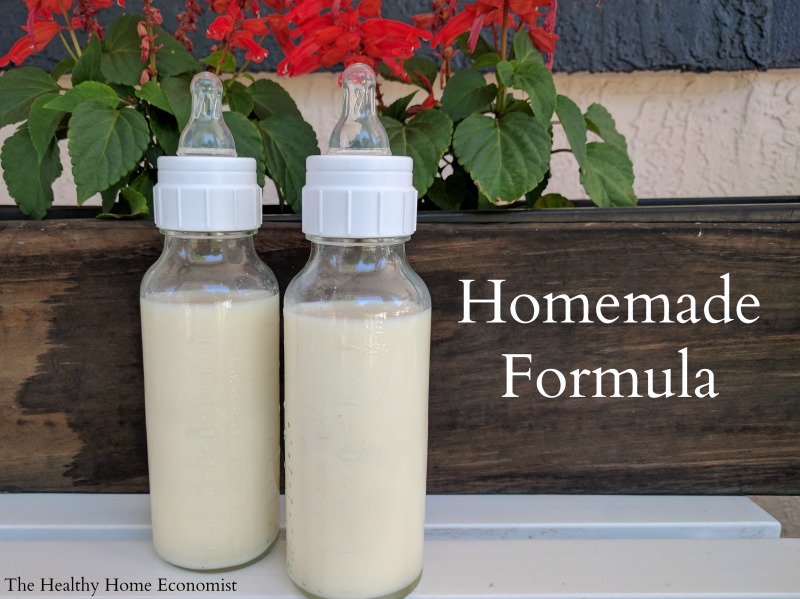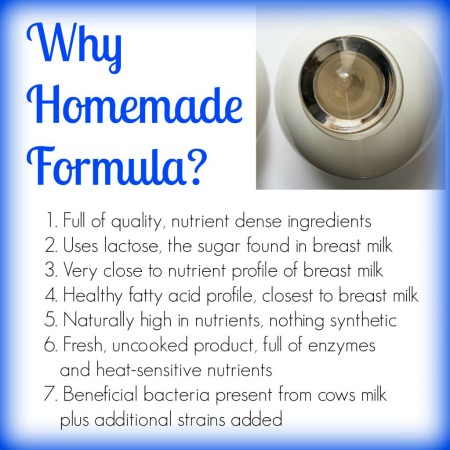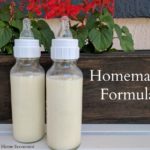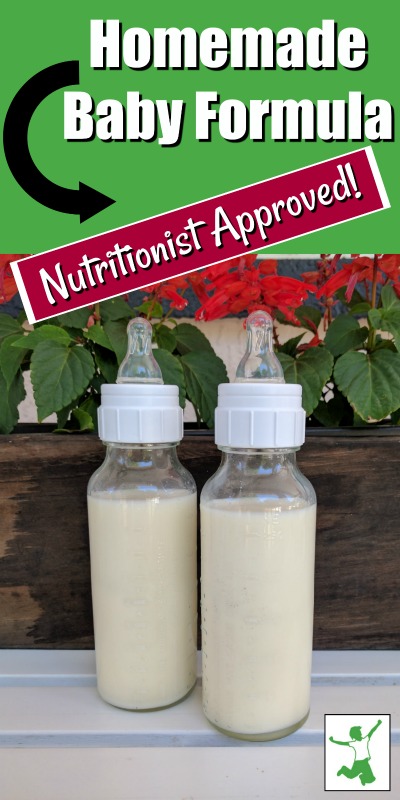Table of Contents[Hide][Show]
A nourishing homemade baby formula using safe, whole ingredients. This recipe was developed and tested by Dr. Mary Enig, a PhD Nutritionist and originally published in Nourishing Traditions cookbook in 1996. It was formulated to match breastmilk as closely as possible and is also suitable for infants. Source: Weston A. Price Foundation

There is no doubt that breastfeeding your baby is the best option for the child’s long-term health and development. Human breastmilk from a well-nourished mother is the perfect food for baby. However, in circumstances where the child is adopted or the Mother finds herself unable to breastfeed, formula feeding becomes necessary. In those cases, homemade baby formula is best.
Using a baby formula recipe that closely matches the nutritional profile of breastmilk is a far better choice than even organic baby formula from the health food store. More on this below.
Note: Donor programs are widely available for human breastmilk. But, the diets of the donor mothers are unknown and most likely nutritionally insufficient. In addition, breastmilk banks pasteurize the donated breastmilk which destroys much of the nutritional benefit. Unless you are fortunate to have a trusted and direct donor milk source in your community, avoid this option!
Dangers of Commercial Formula
Commercial formulas are always a poor choice for a number of reasons. First of all, formula manufacturers line the cans with the chemical BPA. This substance disrupts hormone development and is a probable contributor to early puberty in girls, and ADHD, urogenital abnormalities, and other ills in boys.
The European Food Safety Authority found that canned commercial formula is a significant source of BPA for infants, exposing the child to 13mcg of BPA per kg of body weight per day! BPA-free formula cans are no better. The chemical BPS is typically used instead which is just as dangerous.
Beware that manufacturers pack even organic commercial formula like Earth’s Best in BPA cans. Worse, they use organic brown rice syrup as the primary sweetener which is known to be frequently contaminated with arsenic.
In addition, all commercial milk formulas are processed at extremely high temperatures which violently denature the fragile milk proteins, render them allergenic, and add carcinogens to the final product. Soy infant formula is the worst. Obscenely high processing temperatures not only denature the proteins but large levels of phytic acid in soy block mineral absorption by the infant. Moreover, soy-based plant estrogens disrupt the hormonal development of the baby!
It seems that for the concerned Mother who is unable to breastfeed, learning how to make baby formula at home with safe, pure ingredients is the most prudent way to go!
Why Make Homemade Formula Even if You Are Breastfeeding
In the video below, I show you how to make your own safe, healthy raw milk homemade formula for your baby.
The recipe I follow was originally published in the cookbook Nourishing Traditions in 1996 and developed by Dr. Mary Enig.
Even though I breastfed each of my children for at least 2 years, I made this exact formula for my own children when I was away for the day or the evening as pumping was not an option that worked well for me.
I even used this homemade formula for an entire day once when I had some dental work done and was advised to pump and discard for 24 hours.
As a result, even successfully breastfeeding Moms can use this wonderful homemade formula as a supplement when necessary to their own nutrient-dense breastmilk!
It is advised that even breastfeeding Mothers have the ingredients for this formula on hand for an emergency. If Mom is sick or otherwise unable to nurse, Dad can step in and make this safe alternative until Mom is back on her feet. It takes a few days to a week to gather all the ingredients together to make this formula, which is why I advise having them on hand at all times.
Homemade Most Nutritious
The image below lists the reasons why it is worth it nutritionally to make formula yourself for your precious baby!
You can order all of the required ingredients for the homemade baby formula in one package from this reputable, vetted source.
Moms who have successfully used this formula feeding your children, please post about your experience in the comments section to encourage those who are considering it and need some Mom to Mom encouragement!

Where to Source Quality Milk
The most widely available grass-fed milk around the world is from cows. This is usually the most budget-friendly and easily sourced milk for this recipe for homemade formula.
If only goat milk is available in your area, this recipe for goat milk baby formula can be used instead. When using milk from ewes, please refer to the linked article for an adjusted recipe; one of the benefits of sheep milk is that it is higher in healthy fats than either goat or cow milk.
Camel milk formula is another option that is a particularly digestible form of dairy and growing in popularity around the world.
Alternatively, you can use low temp (vat) pasteurized, non-homogenized whole milk cultured with a piima or kefir starter. Then substitute the piima milk or kefir for the raw milk portion of the formula recipe. Cold-pressed raw milk also must be cultured before using it as it contains no probiotics.
Do NOT use ultrapasteurized (UHT) milk even if organic as it is too highly processed and extremely allergenic!
It is also best to avoid all types of powdered milk for this recipe. The factory process of making milk powder reduces nutrition considerably and denatures it, which makes it more likely baby will have an allergic reaction.
Dairy Allergy Option
If all types of dairy prove unsuitable for your baby, make this nondairy baby formula recipe instead. It uses a base of homemade bone broth as a substitute for milk. It is important not to utilize a plant-based or otherwise vegan baby formula recipe.
Avoid buying bone broth to make the dairy-free formula. Make it yourself! Manufacturers of commercial bone broth, even if authentic, may water down the end product. This is apparent if it does not gel when chilled in the refrigerator.
Many brands have toxic packaging issues as well. If you must buy it in a pinch, see my shopping guide page for vetted brands that are safe.

Homemade Baby Formula Recipe (for infants too)
A nourishing baby formula recipe you can make at home with safe, whole ingredients developed and tested by a PhD nutritionist to match breastmilk as closely as possible. Also suitable for infants.
Ingredients
- 2 cups raw cow milk OR organic whole milk yogurt
- 1 7/8 cups filtered water
- 1/4 cup liquid whey
- 4 Tbl lactose
- 1/4 tsp Bifidobacterium infantis powder
- 2-4 Tbl raw or pasteurized cream
- 1/2 tsp cod liver oil unflavored
- 1/4 tsp butter oil unflavored
- 1 tsp sunflower oil preferably organic
- 1 tsp extra virgin olive oil preferably organic
- 2 tsp virgin coconut oil preferably organic
- 2 tsp nutritional yeast
- 2 tsp gelatin
- 1/4 tsp acerola powder
Instructions
-
Fill a 2 cup Pyrex measuring cup with filtered water and remove 2 TBL (this will give you 1 7/8 cup water).
-
Pour about half the water into a pan and turn burner on medium.
-
Add the gelatin and lactose and let dissolve, stirring occasionally.
-
When gelatin and lactose are dissolved, remove pan from heat and add the rest of the water to cool.
-
Stir in the coconut oil and butter oil until melted.
-
Put remaining ingredients in a glass blender.
-
Add the water mixture and blend for about 3 seconds.
-
Place formula in glass baby bottles or a glass jar and refrigerate.
-
Before giving to baby, warm glass bottle in a pan of hot water or a bottle warmer. NEVER microwave baby bottles!
Recipe Video
Recipe Notes
If using raw cow milk from holstein cows, use 4 Tbl of extra cream (otherwise use 2 Tbl extra cream).
If choosing to make this homemade formula with camel milk, be sure to include 4 Tbl extra cream as camel milk is lower in cream than cow milk.
Do not use high oleic sunflower oil. Use only the brand recommended in the ingredients list which is cold pressed, organic, unrefined, and low oleic.
*Do NOT use powdered whey from the store as it is denatured. Avoid whey from making cheese as it will curdle the formula.
*Do not substitute pasteurized or powdered milk as these are heavily processed, denatured and allergenic foods.
*Do NOT use ultrapasteurized (UHT) cream. It is highly allergenic. Raw or pasteurized cream is acceptable.
*Do NOT use fish oil or krill oil instead of high vitamin cod liver oil as they do not contain any Vitamin D and very little to no Vitamin A.
Collagen powder may be substituted for the gelatin in a pinch (more on peptides in baby formula in this article).
If you are wondering where is the iron in homemade baby formula, this article provides an explanation.
If baby experiences constipation using this formula, try adding 1 tsp of molasses to each batch. This should help move things along.
How to Transition to DIY Formula
Once you’ve viewed the video, gathered the ingredients, and made your first batch, how do you feed it to your baby for the first time?
It is important not to switch all at once as this can cause gas, excessive spit-up, or an uncomfortable change in diaper habits such as constipation or overly loose stools.
Start by giving your baby three-quarters of the old formula blended with one-quarter of the homemade. Try this ratio for a day or two and see how your infant responds.
If no digestive upset or major change in diaper habits occurs, increase the amount to a 50-50 blend of old formula to homemade. Observe for another day or two as before.
If no major issues, increase once again to three-quarters homemade formula to one-quarter old formula. If baby does well on this blend for a third time, you are ready to fully transition to the homemade formula.
At any time during the transition, symptoms of intolerance emerge, back up to the previous successful blend ratio and stay there for a day or two before attempting to increase once again.
Homemade Formula FAQ
Weston Price Foundation
Feeding an Adopted Baby
Traveling Tips with Baby Formula Made at Home
Iron in Baby Formula
Collagen Peptides instead of Gelatin for Homemade Formula?










Jazmin Sanchez Carmen Cabrer Lacted Kristy Bundy Jessica Biser Jessica Boger Kimberly Yeates
That’s PUMP and discard not toss and discard! LOL
That’s PUMP and discard not toss and discard! LOL
can anyone tell me how long I can keep homemade whey and cream from raw milk in the refrigerator? I am going out of town for two week and my parents are keeping my son until I get back in town and I am not comfortable enough for them to make the homemade formula.
how long can I keep homemade raw cow formula in the Freezer ?
Thank you very much
mike
Please be aware that as of very recently BPA has been removed from commercial baby formula containers-Google it. That being said I am making this formula to wean my 9 month old twins off of breastfeeding as I feel more comfortable with these ingredients than what I see in commercial formula. I came back to this forum to find renewed motivation to keep making this formula, it’s expensive and a lot of work and the powdered stuff just seems So much easier. Some issues I am having with this formula are making me question if it is worth it…
What research proves that these ingredients and ratios are providing our babies with everything they need?
It separates in the bottle, have to shake constantly or baby gets a mouthful of oil
It is so greasy, very difficult to get off bottles
The Acerola powder never blends
The babies spit up smells god awful and looks curdled
I wonder if any other mothers are experiencing the above and losing motivation to continue making homemade formula.
Thanks
Jody, I can’t think of any research off the top of my head that I don’t have to go searching for, but my daughter went on this formula after being on commercial, grew well, started to thrive, and because of particular issues she has had several blood draws while on this and after that showed she was in perfect health and getting plenty of what growing babies need. I feel pretty confident saying that it will cover what babies need to be healthy as long as you make sure they’re getting enough calories as they grow by making necessary adjustments or introducing solids.
As for the issues you’re having, we never had those issues. Which oil is separating? If it’s the coconut oil, it helps to melt it in a little bit of warm water first and then add that to the mix. When are you adding the acerola powder? One of the first ingredients or toward the end? I found adding fine powdery dry ingredients before the liquids were in could cause things to clump and not mix well. It blends smoothly when they are added after most of the liquid ingredients. Or, it could be an issue with your blender. More likely when you’re adding it though. We never had issues with it being too greasy or sticking to containers. I would definitely try melting the coconut oil if you haven’t already been doing that and then add the oils after the milk and water are already in it.
Ok so I’ve been doing this for 4 months, hope this helps. Whisk the acerola powder into the water oil mixture before adding it into milk whey mixture should blend. The formula is greasy because of the oils which are vital for baby, find a way to deal, bottles come clean in real hot water or a sanitize cycle of your dishwasher. How are you heating the bottles? The separating of the formula could be due to how your warming the bottles. Check out the Kiinde Kozii warmer its expensive but worth it. It warms gently as to not damage the delicate proteins and enzymes in the raw milk. All spit up stinks make sure baby is burped well and keep upright for a bit after feeding should minimize spitting. If not check with you health practitioner could be some kind of reflux. As far as research goes check out the nutritional equivalents in the Nourishing Traditions book of Baby and Child Care. Good luck.
Jody, we just started my 8 week old granddaughter on this formula and I get what you are saying about the greasiness, although we use glass bottles and it doesn’t stick to those. However, we do use the Dr. Brown’s bottles that have a blue plastic air thingamabob in them and THAT is hard to clean. My guess its all the fats in the formula. She is spitting up some curdled formula as well (she has reflux so she spits up a lot regardless of whether she is getting breast milk or formula). I’m not sure that is a bad thing (the curdles – I KNOW the reflux is a bad thing!). Raw milk does curdle, denatured/pasteurized milk doesn’t do that. I notice a little of the reddish acerola powder in the formula, but it gets sucked down through her #1 size nipple, so I don’t see it as a problem. Anyway, we’re going to continue giving it a try to see how she does.
I was able to get whole milk from a farm. Could anyone explain or tell me the steps making both whey and the cream to make the formula. Thank you somuch – See more at: https://www.thehealthyhomeeconomist.com/video-homemade-milk-based-baby-formula/#sthash.vueK5Qi1.dpuf
Cream: if the milk is raw, the cream will rise to the top of the milk, just scoop it off. Or put milk inyo a container with a spout at the bottom, let separate. Drain milk through spout until you start getting cream, stop. Now you have a jug of only cream to use.
Whey: the easiest way is.to buy plain yogurt, scoop some into cheesecloth, tie up the ends and hang over a bowl. The whey will drip out, use that.
DO NOT USE WHEY FROM STORE BOUGHT YOGURT!!! I tried this, with plain, organic, whole milk yogurt and almost had to call an ambulance for my 4 month old son. He started having violent vomiting and diarrhea, so rapid he couldn’t even cry. He was lethargic, white, with white lips, and even the color from his beautiful blue eyes had turned to grey…it was THE most devastating thing I’ve ever had to experience with any of my children and he is my 4th. I firmly believe that this only happened because I had made the formula with the organic yogurt whey (which is pasteurized) instead of raw milk based whey. So, my advice is, don’t skip any steps! Make it without the whey and add extra lactose if you need it immediately, but don’t rush the whey process because results could be devastating for your baby!
Oh, and I’m a pediatric Emergency Room nurse…I don’t call or even think to call an ambulance unless it is truly an emergency…
We used organic store bought yogurt to make the whey and never had any issues with it. Made it a couple of times a week. Sounds like you just ended up being unlucky with a bad batch. Things unfortunately get contaminated sometimes. The same thing is possible with raw milk as well, even though it doesn’t nearly happen the way conventional nutrition would have us think (I’m a raw milk drinker). Contamination isn’t impossible with anything. It’s good to be aware that this has happened to people so that we try to source our products the best way possible and be sure to check what we’ve gotten for problems as much as we can, but we can’t demonize an entire possible resource over a single incident. That’s one way in which we’ve ended up with raw milk being viewed as dangerous (ridiculously) to begin with.
Anyone using this formula have a baby with severe cradle cap? Does this cause some sort of deficiency?
Hey Sarah, I was able to get whole milk from a farm. Could u explain or tell me the steps making both whey and the cream to make the formula.
Thank you somuch
Hello Sarah, i started homemade cow’s based formula for my son and he is gassy and i removed lactose but it wasn’t sweet enough for him to drink and then I removed whey. Should I just try to remove a yeast flakes to see if that’s what’s causing the gas?after I started supplementing with formula he did not poop for 5 days.